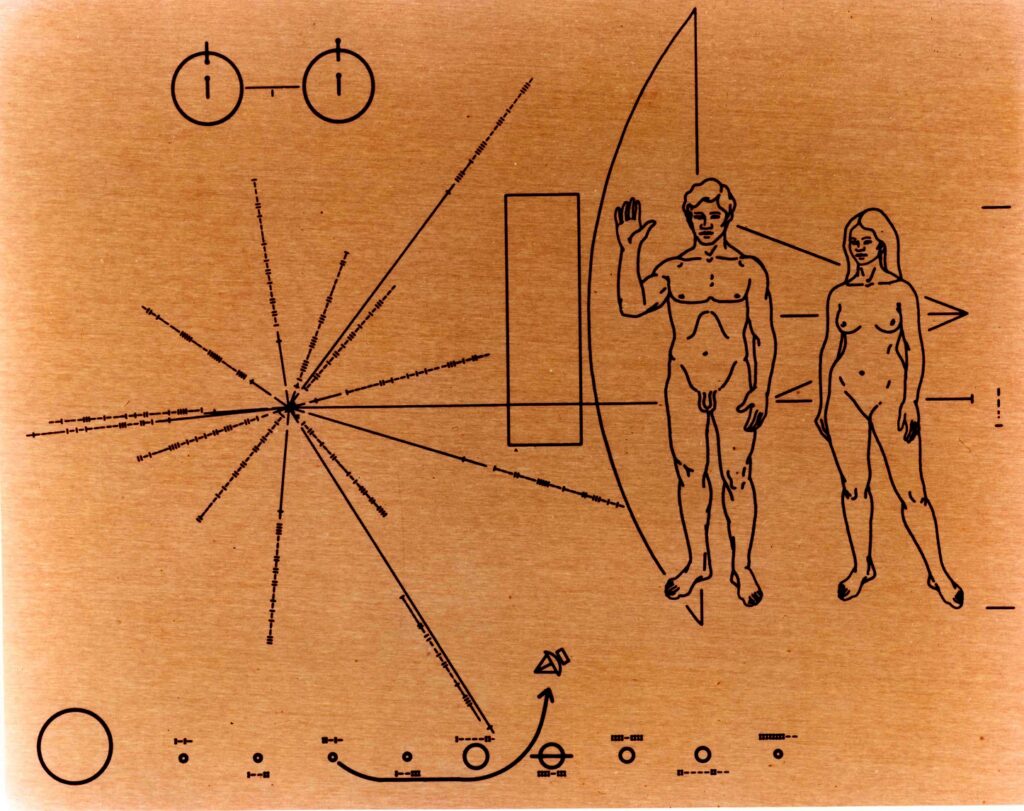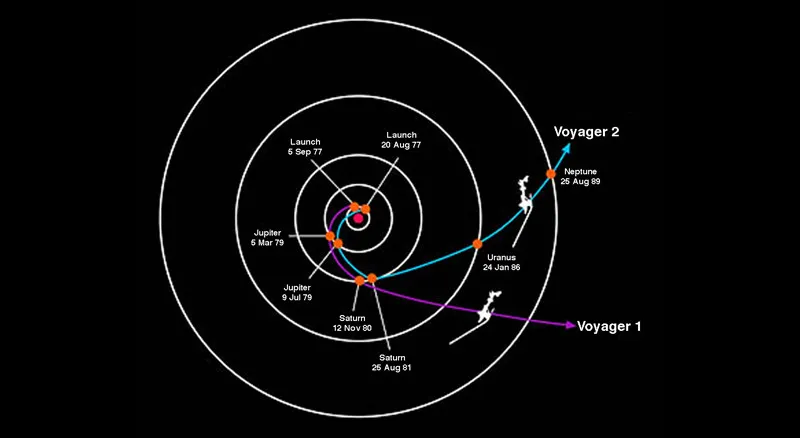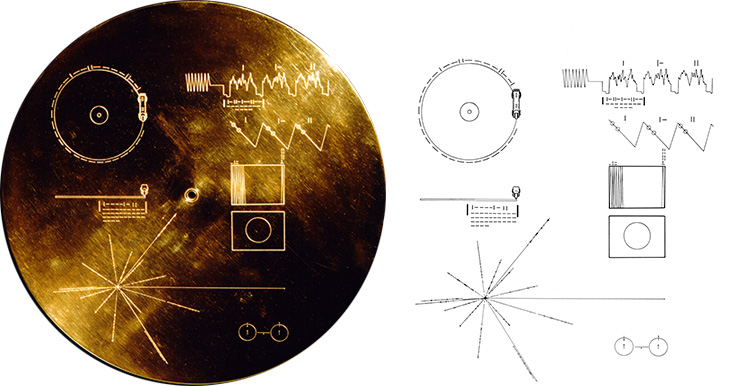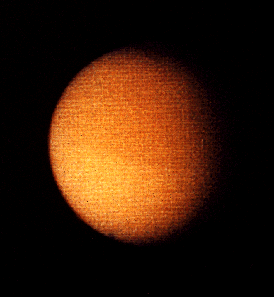the best-known space probes and a few words about their predecessors
Because the Voyagers are not the first planetary probes equipped with our messages and sent them out to leave our solar system.
The Pioneer pair are the first with such goals. Within the framework of the Pioneer program, the Sun, Moon, Venus, among others, were investigated. The Pioneer 10-11 probes were tasked with Jupiter and Saturn.
They were the first to use the swing – by maneuver in a planned manner and not to solve the energy supply with solar panels.
You can read more about these below, in connection with Voyager.
And they got a metal plaque too.
The plaques have a map, what show where is our Solar System is located in relation to some easily identifiable pulsars. The planets of our Solar System are also on it, our Earth is marked separately, and male and female bodies proportional to the size of the probe are also included on this plaque.
PIONEER – 10
It launched on 3th March in 1972, and arrived at Jupiter on 3th in December of the same year. The first spacecraft that passed through the inner asteroid belt (between the last inner and the first outer planet; Mars – Jupiter) and took close-up pictures of Jupiter. The probe imaged the planet and its moons, made measurements of its atmosphere, interior, magnetosphere, etc. Until 1998, it was the first and only one who ventured farthest from our Earth.
It conducted scientific investigations in the outer regions of our Solar System until 31th March 1997, after which it set off to leave it.
We don’t know what happened to it. We received the last signal from the probe on 23th January 2003, and it was very weak.
If the Pioneer – 10 is still on the way, it is heading towards the star called Aldebaran, which is the “eye” of the Taurus (Bull) constellation.
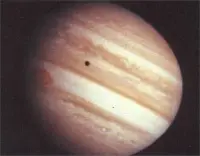
PIONEER – 11
On April 6, 1973, it followed its brother to the Jupiter. In September 1979, it also passed by Saturn. It made measurements and took pictures of both planets.
In September 1995, the connection with the probe was broken. If it is still on the way, it is heading towards the Aquila (Eagle) constellation.
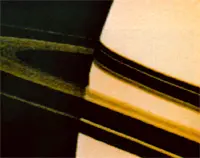
THE VOYAGERS
In the 1960s, calculations were already made at NASA about when it would be worthwhile to send probes to explore the planets of our Solar System. They discovered a planetary conjunction that occurs more than every 130 years. According to calculations, Jupiter, Saturn, Uranus and Neptune will line up almost in 1978.
The outer planets of our Solar System: The Gas and Ice Giants.
The swing – by maneuver was also used with Voyager, which means that when moving along a pre-calculated trajectory, entering the gravitational field of the given celestial body, it essentially throws the spacecraft, which gains extra speed and moves on in the calculated direction (gets a geller). Thus, it was sufficient to get the probes to Jupiter only with rockets and fuel. This is how the Voyagers travelled from planet to planet. =)
This required the aforementioned rare planetary alignment.
The preparations
The designs of the probes and the most accurate calculations of the trajectories have begun. Originally, 2 – 2 probes would have set off, but the budget didn’t allow it.
One of the biggest problems was the power supply. The solar cell could not be considered, because Jupiter is already too far away for the device to be able to produce a sufficient amount of energy.
Nuclear energy could be considered.
The engineers had to design and build a mini nuclear power plant capable of continuously supplying the probe with energy.
They received huge parabolas with which they can communicate with the Earth from 100 million km away. And got various devices, such as a plasma spectrometer, a spectrometer working in the infrared and ultraviolet range, an imaging system, etc.
Carl Sagan (November 9, 1934 – December 20, 1996) was an American astronomer, planetologist, biologist, astrobiologist, peace activist who had the idea to put Gold Plates on the probes. He also patronized the plaque mentioned at Pioneer, which came from the mind of journalist Eric Burgess (England, May 30, 1920 – USA, March 15, 2005).
Each of the two probes received a gold-plated disc on which you can hear the sounds of the Earth (animal sounds, wind), greetings in 55 languages (including Hungarian), and the great hits of the time. In addition, there were also pictures (115 to be exact, click HERE) and motion pictures. The cover includes instructions for playing of the disc and a map.
And why gold? Because it can take the strain. =) For at least one billion years, the discs will not be damaged by cosmic radiation thanks to the gold coating.
Both probes were completed in 1977. The original destination of both was Jupiter, Saturn, Uranus, Neptune, and then the nearest star system: Alpha Centauri.
The Voyager numbers indicate the itinerary, not the order of launch. =)
On the way
The probes started their ways in the second half of 1977, more than 2 weeks apart. It took them more than 2 years to reach Jupiter, and 4 years to reach Saturn. They took amazing pictures and collected a lot of data about the planets. They discovered new moons, produced a lot of images about our solar system also, not just about the planets.
However, only one probe headed for Uranus and Neptune.
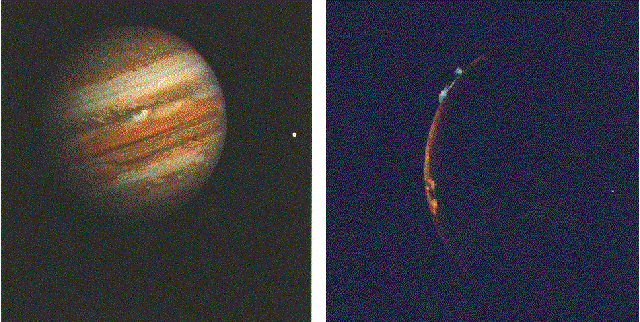
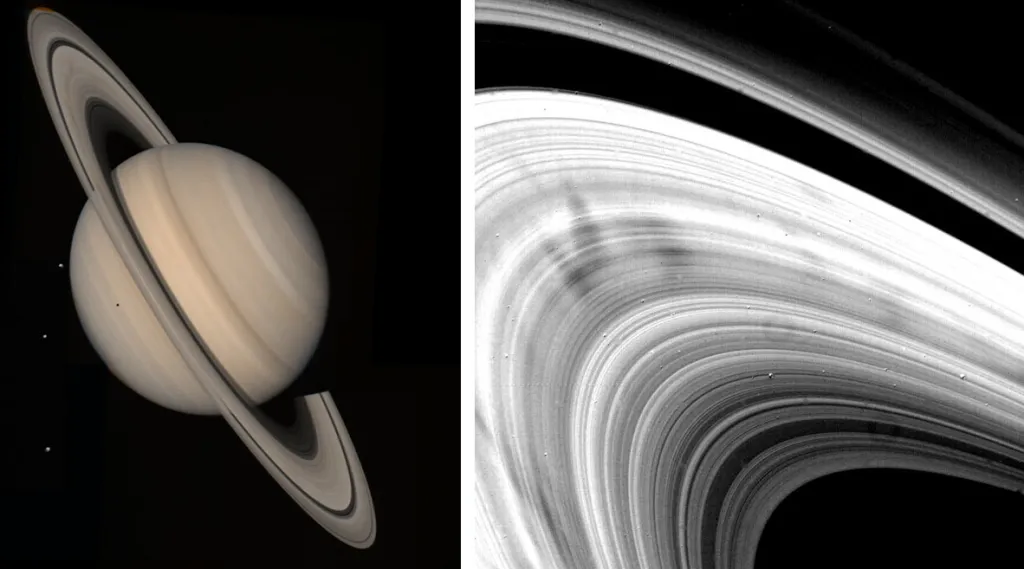
VOYAGER – 1
On September 5, 1977 started its journey to this day, 16 days after the launch of Voyager – 2. On March 5, 1979, it approached Jupiter, then on November 12, 1980, it approached Saturn.
In the end, this probe only examined these two planets and Saturn’s largest moon, Titan.
Due to the Titan, the original plans were modified, even the launch was planned this way. They gave up on the other two gas giants and directed the probe towards the Titan in the hope that it would also be mapped in any possible way. However, this detour did not bring the expected results, because Titan’s atmosphere is so thick that Voyager – 1 could not see through it with its instruments, so it was recorded as a failure, because it could not keep up with Voyager – 2.
I say: this information is also information, although it undeniably came at a high price. After than it went to infinity and further faster and much earlier than its companion Voyager – 2. =)
But if…
It was Carl Sagan’s idea that if there were still enough soufflés left in our explorer, when running only the basic system, then turn back for a moment and take a picture of the piece of our Solar System that had been abandoned until then.
At that time, among other things, the iconic picture of our home was taken:
The Pale Blue Dot.
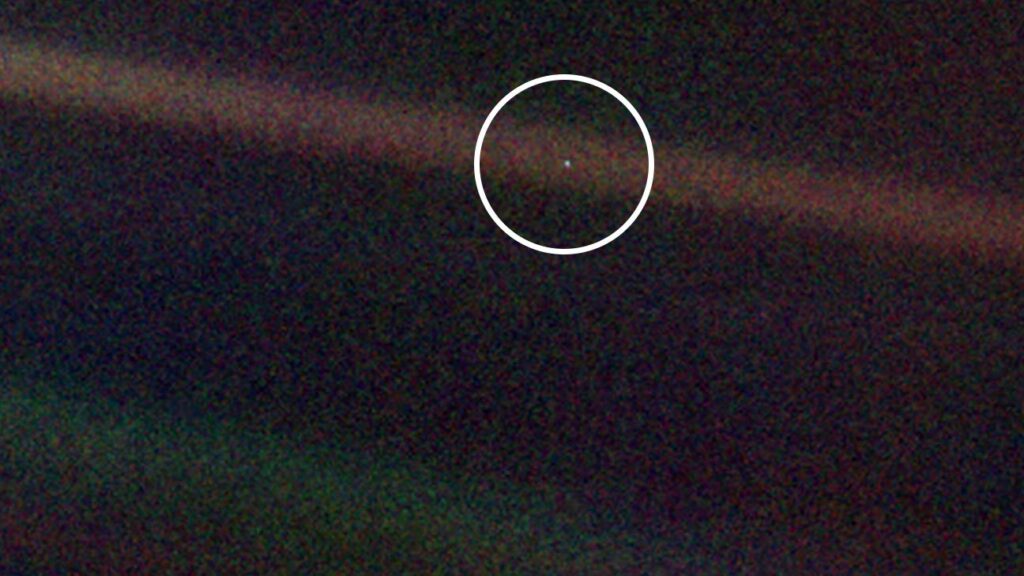
It was 14th February 1990.
We haven’t seen our Little Blue from such a distance since then. =) 6 billion kilometres from our Sun.
The Voyager – 1 entered the Interstellar Space in August 2012.
VOYAGER – 2
On 20th August 1977, started its journey that is still ongoing. The probe reached Jupiter on July 9, 1979 and then on August 25, 1981 to Saturn. It passed through the rings of Saturn, which was risky, but necessary to stay in its proper orbit.
On January 24, 1986 arrived at blue and stormy Uranus, where winds blow faster than the speed of sound (about 1234 km/h).
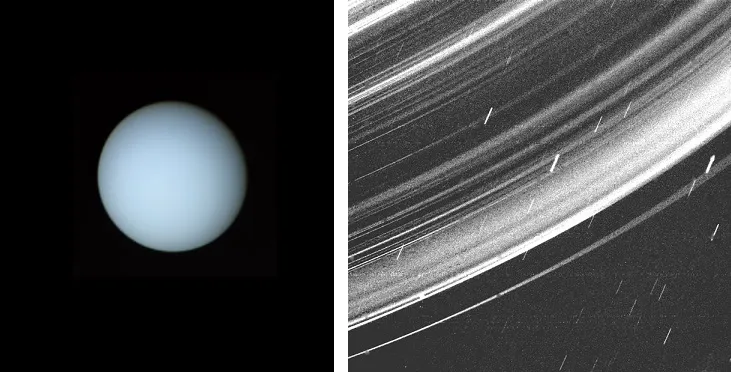
After than on 25th August in 1989 arrived at even bluer and cloudier Neptune.
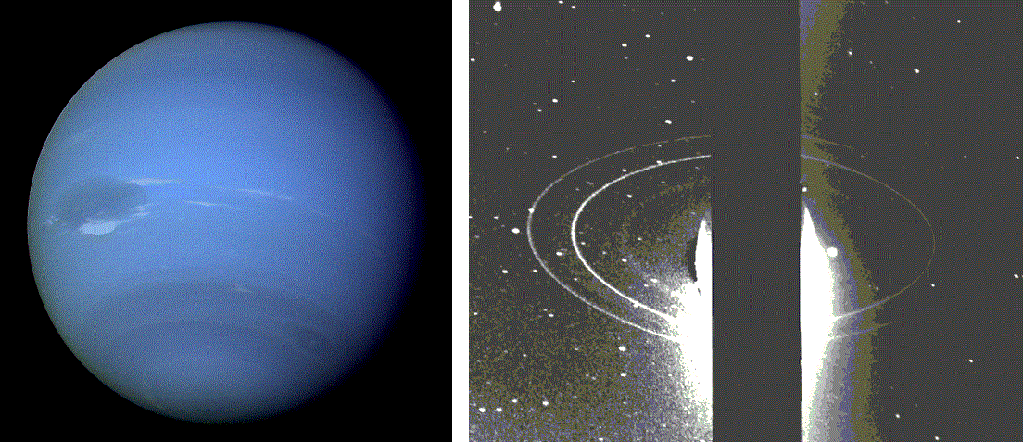
Thanks to the Voyager – 2, we know that all four gas giants have rings, like the Saturn.
In 2018, it entered Interstellar Space, deviating from its calculated trajectory, as a result of which only 1 of the three deep space communication centres (Deep Space Network – DSN) can contact it from Earth, from Australia, which had to be modernized, so the spacecraft was left alone for almost a whole year.
We could only monitor, not issue orders. Of course, then something went wrong with the probe in this period, so we lost contact with it. Then in October 2020, we sent it an order again, when Voyager – 2 confirmed its existence and its ability to communicate. =)
How do we know, the Voyagers entered in the Interstellar Space?
We have to talk about the heliosphere. Shortly.
The heliosphere is a plasma bubble maintained by the solar wind, the Sun’s magnetic field, which protects us from cosmic radiation from Interstellar Space and moves with the Sun.
Leaving this, we end up – almost – in Interstellar Space.
The particles flowing from the sun suddenly gone based on the Voyagers measurements. These values were almost identical for both probes, even though they entered Interstellar Space from different directions and with a difference of 6 years.
Other points of interest
They have roughly 2 million times less memory than today’s smartphones and transfer data 38,000 times slower than the 5G system. We also learned from them, for example, that cosmic radiation increases as solar radiation decreases. And in about 40,000 years they will reach the Alpha Centauri star system.
Where are they going now? You can watch it HERE. =)
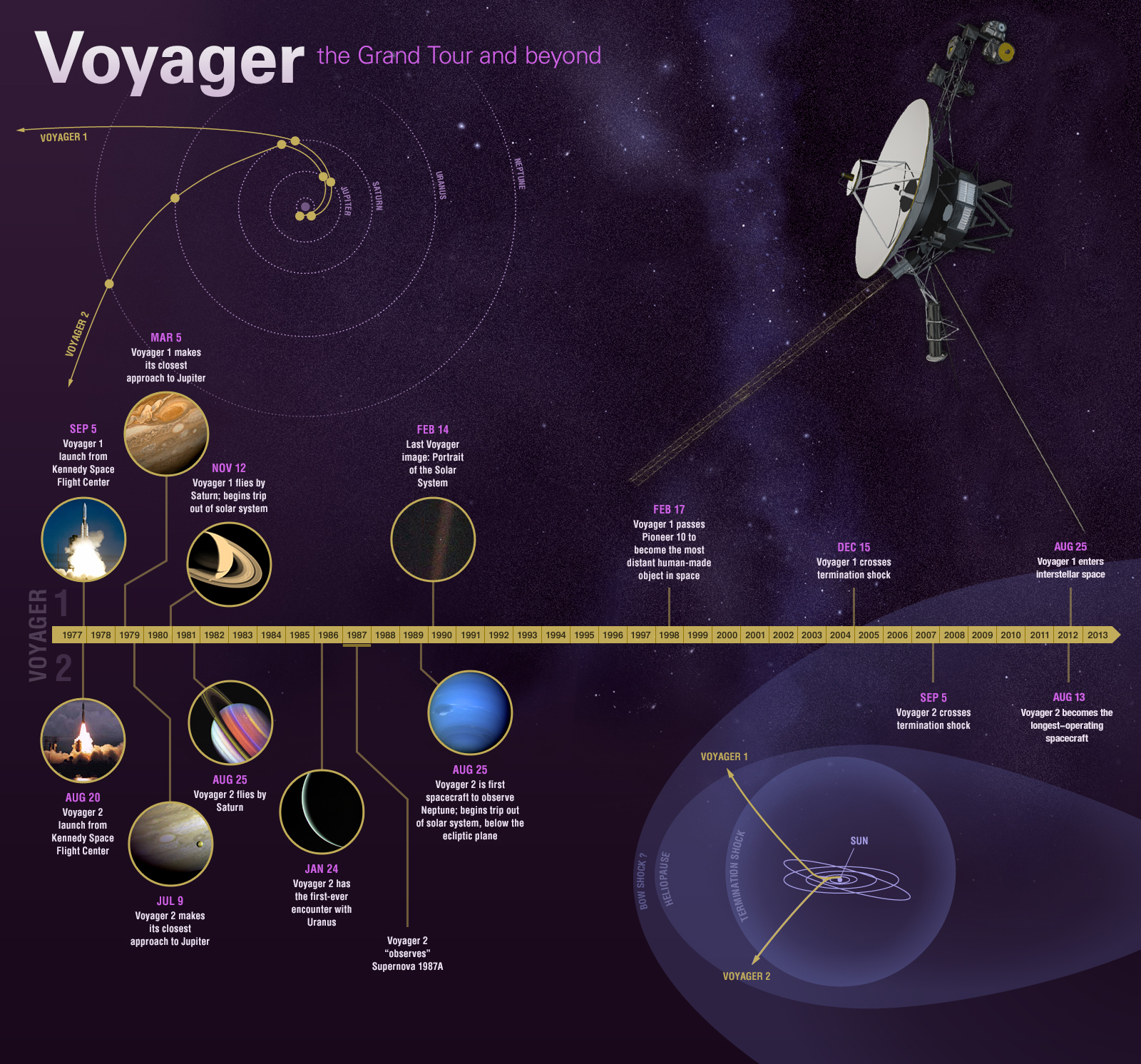
Be a Nerdy Bird!

